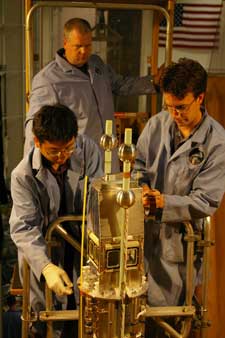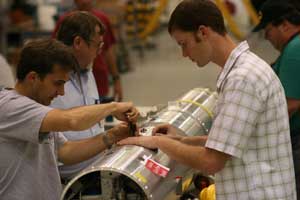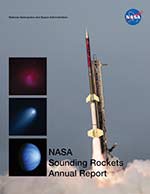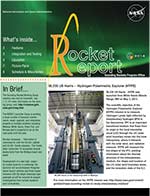 Two sounding rocket missions, 41.069 and 41.0709 were flown from Andoya
Rocket Range in Norway on August 3 and August 6, respectively. Data was
received from all onboard instruments.
Two sounding rocket missions, 41.069 and 41.0709 were flown from Andoya
Rocket Range in Norway on August 3 and August 6, respectively. Data was
received from all onboard instruments.
Sounding Rockets provide a unique capability to take in-situ measurements in high altitude Noctilucent clouds (NLC). These night shining clouds occur mid-May through mid-August in the polar region, and are of interest because they act as indicators of conditions in the upper atmosphere. Sounding rockets have been use several times in the past and were deployed again this summer to carry payloads to study these polar phenomena.
Recently, scientists from Colorado University and University of Washington spent time at Wallops testing and integrating experiments for flights from Andoya rocket range in Norway in August to study both Noctilucent clouds and another related atmospheric pheonomenon, Polar Mesospheric Summer Echos (PMSE). The Principal Investigator is Dr. Scott Robertson/University of Colorado.
 Two
identical payloads, with instruments from both US and international
organizations, were flown on Terrier
Mk12 - Improved Orion sounding
rockets. The instruments include the
Meteoric Aerosol Sampling Spectrometer
(MASS), Colorado University,
e-field booms, University of Washington,
photometers, Stockholm University,
and Faraday antennas, Graz
University of Technology.
Two
identical payloads, with instruments from both US and international
organizations, were flown on Terrier
Mk12 - Improved Orion sounding
rockets. The instruments include the
Meteoric Aerosol Sampling Spectrometer
(MASS), Colorado University,
e-field booms, University of Washington,
photometers, Stockholm University,
and Faraday antennas, Graz
University of Technology.
When the presence of NLCs and/or
PMSE are confirmed by radar or lidar,
the sounding rocket science team coordinated the rocket launches
with the
Aeronomy of Ice in the Mesosphere (AIM)
satellite operations and the Norwegian/
German, Existence and Charge state Of
Meteoric dust grains in the middle Atmosphere
(ECOMA) campaign.
launches
with the
Aeronomy of Ice in the Mesosphere (AIM)
satellite operations and the Norwegian/
German, Existence and Charge state Of
Meteoric dust grains in the middle Atmosphere
(ECOMA) campaign.
After lift-off the nose cone separates at
70 seconds after lift-off, at an altitude of
about 67 km followed by the Orion motor
separation a few seconds later. Science
instruments; booms (aft and forward) and
the photometer hood are deployed
between 74 and 76 seconds. The NLC
layer occurs at 82 - 95 km and most of
the instruments will acquire data
between the 80 km upleg and 80 km
downleg portion of the flight. Photometer
data is not acquired on the downleg.




